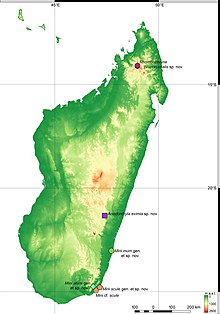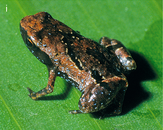Mini mum
| Mini mum | |
|---|---|

| |
| Side view of Mini mum | |
| Scientific classification | |
| Domain: | Eukaryota |
| Kingdom: | Animalia |
| Phylum: | Chordata |
| Class: | Amphibia |
| Order: | Anura |
| Family: | Microhylidae |
| Subfamily: | Cophylinae |
| Genus: | Mini |
| Species: | M. mum
|
| Binomial name | |
| Mini mum Scherz et al., 2019
| |

| |
| Known range of Mini mum (green circle, bottom right) | |
| Synonyms | |
|
Cophyla mum — Dubois et al., 2021 | |
Mini mum is a
The species is very small, measuring only 8.2–11.3 mm (0.32–0.44 in) in
Taxonomy and systematics
Mini mum was described in 2019 by the
The species belongs to the widespread family
The following cladograms show the differing phylogenies found by the 2019 and 2021 studies:[1][4]
|
Description
Mini mum is one of the smallest known species of frog,
M. mum has a rectangular body, with the head being wider than it is long and narrower than the body. The snout is rounded from the top and tapered from the side, with non-protuberant nostrils that are slightly closer to the eyes than the snout. The
Within its genus, it can be distinguished from both M. scule and M. ature by the absence of the maxillary and premaxillary teeth, as well as a more distinct border between the upperparts and underparts along the side. It is also similar to some species in Stumpffia but can be distinguished from them by its poorly ossified carpals, curved clavicles, and a neopalatine (supporting the premaxilla medially) and divided vomer.[1]
The species makes regularly repeated single-note
Distribution and habitat

Mini mum has an extremely limited range, being known only from areas in the Manombo Special Reserve. It is thought to inhabit open lowland forest around the reserve with short trees, lianas, and thick layers of dead leaves, at elevations of 0–100 m (0–328 ft).[1]
Ecology and conservation
Males of the species vocalize during the day while hiding between roots and in leaf litter, some meters away from other vocalizing males. A female specimen collected in late March contained four eggs, while the male holotype had several arthropods (thought to be
Although M. mum has not been assessed by the International Union for Conservation of Nature, the authors of the article in which it is described recommended that it be listed as critically endangered due to its extremely small and highly deforested range.[1]
References
- ^ PMID 30917162.
- ^ a b Solly, Meilan (28 March 2019). "Meet Mini mum, Mini scule and Mini ature, Three New Frog Species Among the World's Smallest". Smithsonian Magazine. Retrieved 22 October 2022.
- ^ "Meet Mini mum, Mini ature, Mini scule: Tiny new frogs from Madagascar". Mongabay Environmental News. 28 March 2019. Retrieved 22 October 2022.
- ^ .
- ^ Scherz, Mark D. (28 March 2019). "Meet the mini frogs of Madagascar -- the new species we've discovered". The Conversation. Retrieved 13 November 2022.


